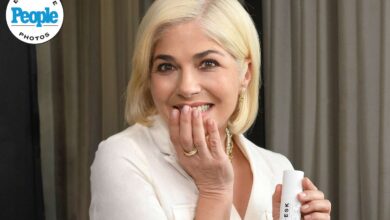Mom of Twins Refuses to Use Disposable Diapers, Tries Other Method (Exclusive)
:max_bytes(150000):strip_icc():format(jpeg)/A-mom-is-committing-herself-to-being-diaper-free-092325-1-425cf29b1d0e4de385da56a38cef273d.jpg)
NEED TO KNOW
- A mom of twin girls made a bold decision during her pregnancy, resulting in a deeper connection with her daughters
- Catherine Marshall tells PEOPLE that she committed herself to avoiding disposable diapers and embracing elimination communication
- The doting mom tells PEOPLE that the feeling of knowing exactly what her daughters need is “fulfilling,” describing it as the “first step” toward direct communication
One bold decision from a mom while pregnant resulted in a deeper connection with her babies than she could have ever imagined.
When Catherine Marshall was pregnant with her twin girls, Violet and Meadow, she committed herself to one thing: avoiding disposable diapers. That decision led the doting mom and her husband, Ryan Marshall, to discover elimination communication, which Catherine says has been “incredibly insightful for understanding our babies’ cues and cries.”
“When I learned about elimination communication, I realized how naturally it pairs with cloth diapering and how little extra effort it takes, so it just made sense,” she tells PEOPLE. “Beyond reducing diaper laundry, elimination communication has been incredibly insightful for understanding our babies’ cues and cries.”
“What we once labeled as ‘discomfort’ or ‘gas pain’ turned out to be warning cries that they needed to pee,” she adds. “Once we recognized that, we saw how often babies communicate through body language.”
Elimination communication is an approach where parents monitor their baby’s natural cues for urination and bowel movements, according to pediatrician and published author Letisha Jefferson.
“[Elimination communication] offers opportunities to use the toilet instead of relying solely on diapers,” Jefferson explains. “It’s based on observation, timing, and communication, rather than waiting for the traditional potty training age.”
While she was pregnant, Catherine took the time to read more about the dos and don’ts of elimination communication. She ultimately decided to give it a try when her twin girls came home from the neonatal intensive care unit (NICU). The mom of two tells PEOPLE that her twins have been using the potty ever since they came home.
“Catching every pee isn’t the goal. We simply offer the Top Hat potty as soon as the diaper comes off at each change or after babywearing,” she explains. “Mammals instinctively avoid soiling their caregiver, so babies will often hold it until they’re off of you if given the chance. Learning about this biological response showed me just how instinctual elimination communication is.”
There are several positives to adopting this parenting method. According to Jefferson, elimination communication “can help strengthen the bond between parent and child.”
“Some families find that this method can help strengthen the bond between parent and child because it requires close observation and responsiveness to cues,” she shares. “It may also reduce the number of diapers used, which can save money and help the environment.”
Catherine, whose daughters are now almost 5 months old, highlighted her experience with elimination communication over the past few months in a now-viral Instagram video. She tells PEOPLE that the feeling of knowing exactly what her daughters need is “fulfilling,” describing it as the “first step” toward direct communication.
“When the girls would cry after being changed, fed, and burped, we used to chalk it up to tiredness or gas,” she explains. “Moms know their babies’ different cries for hunger, sleepiness, or pain—and now I’ve unlocked a new one: the pee cry. Meeting that need is so fulfilling, and I’m sure it builds their trust and sense of security knowing their mom understands them.”
Courtesy of Cathy Marshall
Never miss a story — sign up for PEOPLE’s free daily newsletter to stay up-to-date on the best of what PEOPLE has to offer, from celebrity news to compelling human interest stories.
“As they get older and start using sign language or words, I’m confident we’ll communicate even more effectively,” she adds. “This feels like the first step toward that direct connection.”
The doting mom tells PEOPLE that she knows that cloth diapers and elimination communication isn’t the norm, but she recommends it to any mom or mom-to-be who’s curious.
“I understand cloth diapers aren’t for everyone, but they were the norm until the 1940s, when disposables were invented. Before that, elimination communication and cloth diapering were simply how babies were raised—this isn’t new, even if it seems unconventional now,” she says.
“I highly recommend it to anyone curious,” she continues. “It’s far better for the environment (even considering the water used for washing), and it’s healthier to have natural materials against a baby’s skin rather than plastic 24/7 until potty training.”
Credit to Nypost AND Peoples



